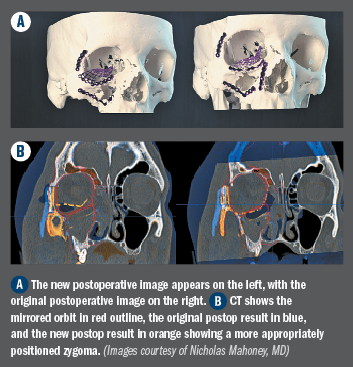Article
Strategies for repairing late orbital fractures
Computer-assisted techniques help achieve the best possible results in complicated cases of anatomic reconstruction.
Take-home
Computer-assisted techniques help achieve the best possible results in complicated cases of anatomic reconstruction.
By Lynda Charters; Reviewed by Nicholas Mahoney, MD
Baltimore-Timing is everything when surgically correcting an orbital fracture. Computer-assisted planning and surgery come into play to help achieve the best possible results in complicated cases of anatomic reconstruction.
“In the case of a recent floor or medial wall fracture without entrapment, we are deciding to perform surgery based on the possible long-term outcome,” said Nicholas Mahoney, MD, assistant professor of ophthalmology, Wilmer Eye Institute, Johns Hopkins University School of Medicine, Baltimore.
“We must decide if enophthalmos will develop once the substantial initial swelling resolves, which can take about 6 months to a year in cases,” Dr. Mahoney added. “We want to make the decision to perform surgery early because the surgery is easier to perform before scarring develops. The ideal time to perform surgery is about 1 to 2 weeks after the trauma.”
When faced with treating a patient with a late orbital fracture, he categorizes patients by which of the common injury patterns they have, that is, a floor and/or a medial wall fracture or a zygomaticomaxillary complex fracture (a tripod fracture).
Computer-assisted techniques, he noted, are used differently with all the fractures.

Planning and navigation
“There are two main uses for computer-assisted surgery, one of which is for preoperative planning,” Dr. Mahoney said.
Preoperative assessment is made using software associated with the navigation machine (iPlan, Brainlab). Intraoperative navigation is used to determine locations during the surgery, he said.
One of the best features of this technology shines in patients who have floor fractures. It allows surgeons to make a map of the undamaged fellow orbit and use that as a template to reconstruct the fractured orbit (mirror image technique). This allows surgeons to see where the plate should be placed.
“We achieve great benefit out of this technology in patients with late fractures because the surgery is frankly harder,” he said.
During intraoperative navigation-done using a technology similar to that in the Wii video console-the surgeon uses two infrared cameras, instruments to be registered, and a device attached to the patient for registration that has infrared markers.
“The cameras know in three-dimensional space where the patient is relative to the instrument,” Dr. Mahoney said. “On computer tomography scans, we can see where the tip of our instrument is in space.”
These techniques can be used regardless of the fracture that the patient has sustained.
However, Dr. Mahoney said he believes that they are more useful in late fractures- the reason being, there is such substantial scarring present that the surgeon does not have good visualization or mobility when instruments and implants have to be moved.
“In patients with floor and medial wall fractures, the surgeon must visualize the back of the fracture to position an implant,” he said. “However, with a great deal of scarring it is difficult to get an entire picture of the status of the back of the eye socket.”
The intraoperative navigation helps determine where we are along the floor and find the back of the fracture (the posterior ledge) where the implants should rest, he explained.
Once the implant is in place, the navigation technology also can be run along the length of the fracture to determine if the plate is in the correct position. Digital markings can be laid down and compared with the mirror-image template of the unfractured orbit.
In patients with zygomaticomaxillary complex fractures and cheek fractures, the surgery includes repositioning of bones. If the cheekbone is fractured, it must be moved. In cases of late fractures, the bone is scarred in place and in most patients the bones may have healed. This requires osteotomies in the places where the bone articulations are fractured.
The mirror image technique is also very useful here to reposition the zygoma in a patient with a late fracture, Dr. Mahoney explained.
Case report
Dr. Mahoney described the case of a man with a zygomaticomaxillary complex fracture that was initially repaired by another surgeon who used standard techniques. The zygoma was not in the right place, and the floor and medial wall plate was positioned in a dangerous spot in the eye socket within the extraocular muscle cone.
Dr. Mahoney and colleagues were then consulted.
In addition to normal scarring over the months from prior surgery, additional swelling developed because of the additional fracture repair and subsequent plate removal surgeries.
Using computer-assisted surgery, Dr. Mahoney replaced all the plates, mobilized the zygoma with osteotomies, and reset the bone position to achieve a successful outcome.
Nicholas Mahoney, MD
Dr. Mahoney has no financial interest in any aspect of this report.
Subscribe to Ophthalmology Times to receive the latest clinical news and updates for ophthalmologists.
Newsletter
Don’t miss out—get Ophthalmology Times updates on the latest clinical advancements and expert interviews, straight to your inbox.




